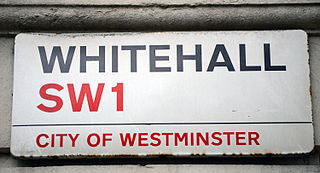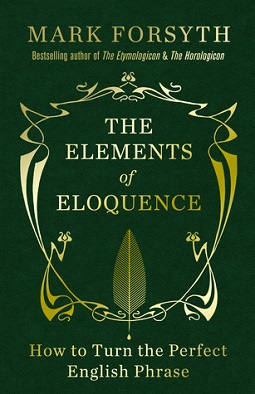Related Research Articles
In grammar, a phrase—called expression in some contexts—is a group of words or singular word acting as a grammatical unit. For instance, the English expression "the very happy squirrel" is a noun phrase which contains the adjective phrase "very happy". Phrases can consist of a single word or a complete sentence. In theoretical linguistics, phrases are often analyzed as units of syntactic structure such as a constituent.
English grammar is the set of structural rules of the English language. This includes the structure of words, phrases, clauses, sentences, and whole texts.

A figure of speech or rhetorical figure is a word or phrase that intentionally deviates from ordinary language use in order to produce a rhetorical effect. Figures of speech are traditionally classified into schemes, which vary the ordinary sequence of words, and tropes, where words carry a meaning other than what they ordinarily signify.
Antithesis is used in writing or speech either as a proposition that contrasts with or reverses some previously mentioned proposition, or when two opposites are introduced together for contrasting effect. This is based on the logical phrase or term.
In language, a clause is a constituent that comprises a semantic predicand and a semantic predicate. A typical clause consists of a subject and a syntactic predicate, the latter typically a verb phrase composed of a verb with any objects and other modifiers. However, the subject is sometimes unvoiced if it is retrievable from context, especially in null-subject language but also in other languages, including English instances of the imperative mood.
In grammar, a conjunction is a part of speech that connects words, phrases, or clauses that are called the conjuncts of the conjunctions. That definition may overlap with that of other parts of speech, and so what constitutes a "conjunction" must be defined for each language. In English, a given word may have several senses, and be either a preposition or a conjunction depending on the syntax of the sentence. For example, after is a preposition in "he left after the fight" but is a conjunction in "he left after they fought". In general, a conjunction is an invariable (non-inflected) grammatical particle that may or may not stand between the items conjoined.
In general linguistics, the comparative is a syntactic construction that serves to express a comparison between two entities or groups of entities in quality or degree - see also comparison (grammar) for an overview of comparison, as well as positive and superlative degrees of comparison.
In rhetoric, a rhetorical device, persuasive device, or stylistic device is a technique that an author or speaker uses to convey to the listener or reader a meaning with the goal of persuading them towards considering a topic from a perspective, using language designed to encourage or provoke an emotional display of a given perspective or action. They seek to make a position or argument more compelling than it would otherwise be.
In linguistics, a determiner phrase (DP) is a type of phrase headed by a determiner such as many. Controversially, many approaches, take a phrase like not very many apples to be a DP, headed, in this case, by the determiner many. This is called the DP analysis or the DP hypothesis. Others reject this analysis in favor of the more traditional NP analysis where apples would be the head of the phrase in which the DP not very many is merely a dependent. Thus, there are competing analyses concerning heads and dependents in nominal groups. The DP analysis developed in the late 1970s and early 1980s, and it is the majority view in generative grammar today.

In rhetoric, an anaphora is a rhetorical device that consists of repeating a sequence of words at the beginnings of neighboring clauses, thereby lending them emphasis. In contrast, an epistrophe is repeating words at the clauses' ends. The combination of anaphora and epistrophe results in symploce.
Asyndeton is a literary scheme in which one or several conjunctions are deliberately omitted from a series of related clauses. Examples include veni, vidi, vici and its English translation "I came, I saw, I conquered". Its use can have the effect of speeding up the rhythm of a passage and making a single idea more memorable. Asyndeton may be contrasted with syndeton and polysyndeton, which describe the use of one or multiple coordinating conjunctions, respectively.
Parataxis is a literary technique, in writing or speaking, that favors short, simple sentences, without conjunctions or with the use of coordinating, but not with subordinating conjunctions. It contrasts with syntaxis and hypotaxis.
In grammar, parallelism, also known as parallel structure or parallel construction, is a balance within one or more sentences of similar phrases or clauses that have the same grammatical structure. The application of parallelism affects readability and may make texts easier to process.
The Rhetorica ad Herennium is the oldest surviving Latin book on rhetoric, dating from the late 80s BC. It was formerly attributed to Cicero or Cornificius, but is in fact of unknown authorship, sometimes ascribed to an unnamed doctor.
Parallelism is a rhetorical device that compounds words or phrases that have equivalent meanings so as to create a definite pattern. This structure is particularly effective when "specifying or enumerating pairs or series of like things". A scheme of balance, parallelism represents "one of the basic principles of grammar and rhetoric".
Owing to its origin in ancient Greece and Rome, English rhetorical theory frequently employs Greek and Latin words as terms of art. This page explains commonly used rhetorical terms in alphabetical order. The brief definitions here are intended to serve as a quick reference rather than an in-depth discussion. For more information, click the terms.
In linguistics, verb phrase ellipsis is a type of elliptical construction and a type of anaphora in which a verb phrase has been left out (elided) provided that its antecedent can be found within the same linguistic context. For example, "She will sell sea shells, and he will <sell sea shells> too" is understood as "She will sell sea shells, and he will sell sea shells too". VP-ellipsis is well-studied, particularly with regard to its occurrence in English, although certain types can be found in other languages as well.
Persuasive writing is a form of written communication intended to convince or influence readers to accept a particular idea or opinion and to inspire action. A wide variety of writings, such as criticisms, reviews, reaction papers, editorials, proposals, advertisements, and brochures, utilize different persuasion techniques to influence readers. Persuasive writing can also be employed in indoctrination. It is often confused with opinion writing; however, while both may share similar themes, persuasive writing is backed by facts, whereas opinion writing is supported by emotions.
In linguistics, scheme is a type of figure of speech that relies on the structure of the sentence, unlike the trope, which plays with the meanings of words.

The Elements of Eloquence: How to Turn the Perfect English Phrase is a non-fiction book by Mark Forsyth published in 2013. The book explains classical rhetoric, dedicating each chapter to a rhetorical figure with examples of its use, particularly in the works of William Shakespeare. Forsyth argues the power of Shakespeare's language was a result of studying formal rhetoric, and highlights their use through Shakespeare's development.
References
- 1 2 Farnsworth, Ward. Farnsworth's Classical English Rhetoric. 1st. Boston: David R. Godine, 2011. 74. Print.
- ↑ Pooley, Robert C. (1958). "What Grammar Shall I Teach?". The English Journal. 47 (6): 327–333. doi:10.2307/808588. ISSN 0013-8274. JSTOR 808588.
- 1 2 Eidenmuller, Michael E. "Rhetorical Figures in Sound: Parallelism." Rhetorical Figures in Sound: Parallelism. N.p., n.d. Web. 22 Oct. 2013.
- ↑ Brooks, Phyllis (1973). "Mimesis: Grammar and the Echoing Voice". College English. 35 (2): 161–168. doi:10.2307/375442. ISSN 0010-0994. JSTOR 375442.
- 1 2 Ebbitt, Wilma R., David R. (1990). Index to English, Eighth Edition. New York, New York: Oxford University Press. p. 182.
{{cite book}}: CS1 maint: multiple names: authors list (link) - ↑ "Parallel Structures in Syntax." Lingua 75.2 (1988): 275-87. Print.
- 1 2 Frazier, Lyn; Taft, Lori; Roeper, Tom; Clifton, Charles; Ehrlich, Kate (March 29, 1984). "Parallel Structure: A Source of Facilitation in Sentence Comprehension". Memory & Cognition. 12 (5): 421–430. doi: 10.3758/bf03198303 . PMID 6521643.
- 1 2 3 Fahnestock, Jeanne (April 1, 2003). "Verbal and Visual Parallelism". Written Communication. 20 (2): 128. doi:10.1177/0741088303020002001. S2CID 144871309.
- 1 2 Webster, Charles, Merriam, George (1989). Webster's Dictionary of English Usage. Springfield, Massachusetts: Merriam-Webster. pp. 433–434. ISBN 0-87779-032-9.
{{cite book}}: CS1 maint: multiple names: authors list (link) - ↑ Strunk, William. Elements of Style. Ithaca, N.Y.: Priv. print. [Geneva, N.Y.: Press of W.P. Humphrey], 1918; Bartleby.com, 1999. www.bartleby.com/141/.
- ↑ Fahnestock, Jeanne (April 1, 2003). "Verbal and Visual Parallelism". Written Communication. 20 (2): 126. doi:10.1177/0741088303020002001. S2CID 144871309.